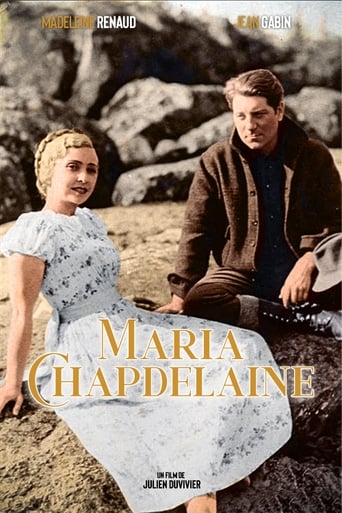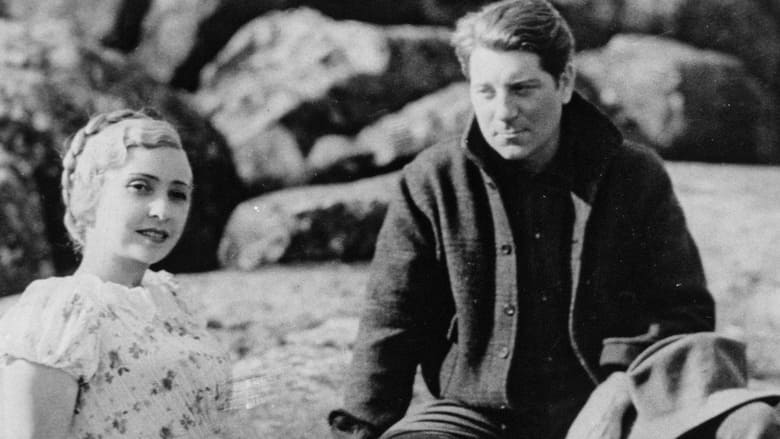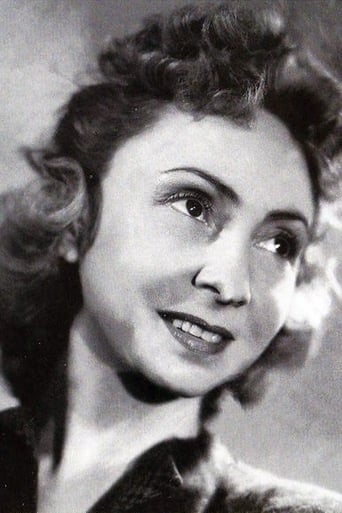Maria Chapdelaine (1934)
A young woman has three suitors on her father's logging ranch on the Quebec frontier.
Watch Trailer
Free Trial Channels
Cast


Reviews
Just perfect...
The acting in this movie is really good.
It's easily one of the freshest, sharpest and most enjoyable films of this year.
I enjoyed watching this film and would recommend other to give it a try , (as I am) but this movie, although enjoyable to watch due to the better than average acting fails to add anything new to its storyline that is all too familiar to these types of movies.
Today I read Maria Chapdelaine, the classic French-Canadian novel by Louis Hemon. This evening I watched Julian Duvivier's 1934 screen adaptation of it, with Jean Gabin and Madeleine Renaud. It's one remarkable film, folks. Often faithful to the novel, but sometimes different, when Duvivier thought of ways that only a great novelist or a great director could have used to tell his story. (Louis Hamon, the author of Maria Chapdelaine, was not a great novelist. An effective one, yes, but not a great one.) One of the things Duvivier uses repeatedly to great effect is juxtapositions of scenes that are happening simultaneously. (Hémon presents them consecutively.) The most remarkable example of this is his depiction of Christmas, when François Paradis is wandering through the forests in a terrible snow storm (recounted by Eutrope Gagnon in Chapter X of the novel), Maria is saying her rosary 1000 times in the hope it will cause the Virgin to send FP to her (depicted in Chapter IX of the novel), and in the church, largely empty, the priest does Christmas mass for the few parishioners who show up. The minutes when the younger daughter, Alma-Rose, sits in her father's lap and sings Christmas carols with him, juxtaposed to a choir singing the same music in the church in Péribonka, is remarkably moving. Another example of such juxtapositions is when Duvivier juxtaposes Eutrope's marriage proposal to Maria with Samuel's regrets at his wife's deathbed for the miserable life he has given her. Eutrope tries to make good the very life that Samuel realizes made his own wife miserable. Hémon makes that contrast over several chapters, but Duvivier does it with immediate juxtapositions, and it is very effective.My only real problem with this movie comes near the end. In the novel, Maria herself comes to a realization that she would rather remain in the north Canadian outback and carry on the 300 year old Franco-Canadian culture that survives there in the wilderness. It is a very powerful realization in the novel, and probably the single thing that made it a classic of French-Canadian literature. In the movie, those ideas get preached to her and the congregation as a whole by the local minister. It comes off as FAR less effective.But other than that, this is a wonderful movie, both as a work of art and as a documentary on the life of northern Canadian farmers and loggers in the first part of the twentieth century, at least as Hémon saw it during his six months there. Each time I watch it I enjoy it more.---------------------I watched Duvivier's juxtaposition of Chapters IX and X again today. It really is masterful.
The movie seems like an attempt to represent Quebec for a French audience, with an emphasis on what's unusual about the province's language, landscape, religious and working practices, etc. There's a lot of music and singing as well (including "Alouette" and other familiar songs of the times), with ultimately only a wisp of a story.The title character, Maria Chapdelaine, is in love with François Paradis, and has to deal with his absence as he leaves to earn his livelihood as a fur trapper over the winter months. I won't say more about the story, because I would spoil the few surprises that it has to offer. Unless you have a fascination for rural life in Quebec in the 1930s, you will find the movie slow going.
Madeleine Renaud plays the title character--a young woman living in the French-speaking part of rural Quebec--the part that almost always seems like it's freezing cold! She falls in love with a trapper who has plans of settling down and becoming a farmer (Jean Gabin in one of his early roles). However, he wants to finish up the season and then come back to marry her. Eventually, however, he freezes to death and is eaten by wolves--leaving Madeleine miserable and being pursued by two new suitors. While this is the plot, the film really is much more of a meandering slice of life film. It shows life in a rural village with all its many privations. About the only joy I saw was around Christmas (and the people singing was quite lovely) but then only minutes later Madeleine got word about her dead fiancé! What a great way to celebrate, huh?! While this is a very lovely film to see, it's also a very, very slow film. If you are French-Canadian, you'll no doubt enjoy it much more. And, if you are a sociologist or history teacher, you might also get more out of the film--as it records a lost way of life. But, for the rest of the people out there this will probably be very slow going. Tedious at times and grim, you may need to force yourself to stick with this one.By the way, if you do like this film, try "Mon Oncle Antoine". It's also set in French-Canada and is about rural life. However, if you didn't love "Maria Chapdelaine", then you'd best avoid "Mon Oncle Antoine"!
...you who love the French culture and without whom I could not have written these comments on Duvivier's earlier films which I had not seen for years."Maria Chapdelaine " is Canadian,you're going to tell me.But Duvivier almost treated Hémon's book as a musical.And all the songs we can hear are part (with the exception of "Alouette" ,pure Canadian stuff,but which is popular in France too)of the French national heritage.Songs of love "A la Claire Fontaine",François Paradis's favorite, country songs ("Marianne s'en Va-t-Au -Moulin" ), naughty ditties (the delightful "Son Voile qui Volait") ,Christmas carols ("Minuit Chrétiens "(aka "O Holy Night" ) and "IL est Né Le Divin Infant")and more more....More a chronicle than a real story,"Maria Chapdelaine" is one of the rare Duvivier movies which do not feature villains.No evil here but people who have to struggle hard all their life against a hostile nature (the horse falling in the snow is a beautiful metaphor) ;the only culture they get is religion ("Maria ,if you say 1,000 "Ave Maria" before Xmas,your dream will come true") or superstition (the bonesetter).Gabin's first part (and it will not be the last!)in a Duvivier's movie:Duvivier really MADE Gabin.Jean-Pierre Aumont appears in a part of a young man who has moved to the city.The cinematography is dazzling (even is the copy is as awful as you said ,Oystein):they say Ingmar Bergman used to dissect Duvivier's works.








